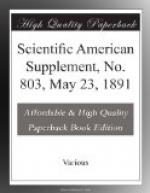-------------------------------------------------------
---------------- | | Section of Mains Tested. | Length. |No. of | |Tests. | | ---------------------------------------------------+--------
----+------ | yards. | From the central station to the end of reseau and | | back to central station by return circuit | 18,100 | 7 From the central station to the Rue Fontaine au |\ 14,600 |/ 3 Roi |/ 9,900 |\ 4 From the central station to the Rue de la | | Charonne | 9,490 | 5 From the Rue de la Charonne to Fontaine au | | Roi | 4,770 | 3 From the central station to the Avenue de la | | Republique | 1,860 | 8 Various trials on different lengths of mains |770 to 8,000| 11 ------------------------------------------------------------
-----------
Over the whole system of 16.5 kilometers, which was also tested when no air was being taken off, there were four reservoirs of considerable size, and which offered a large resistance with a corresponding loss of pressure; on the line there were also 23 siphons and 42 stop valves.
These trials were repeated several times to secure accuracy, and the speed of the air was brought to 49 ft. a second. The results obtained in one of these trials may be taken as an example. The main between the Rue St. Fargeau and the Fontaine au Roi, on which there are no collecting reservoirs, but three siphons and eight stop valves, gave, with an average speed of 21 ft. 3 in., a loss in pressure of 0.05 atmosphere for each kilometer of main.
From these experiments it would appear that, assuming a speed of 21 ft. per second, a loss in pressure of one atmosphere would correspond to a distance of 20 kilometers; that is to say, a central station could extend its mains on all sides with a radius of 20 kilometers, and the motors at the ends of the lines would receive the air at a pressure 15 lb. less than at the central station. Professor Riedler states that as an actually measured result, the velocity of the air through the mains of the St. Fargeau system is 19 ft. 8 in. per second, and that the loss in pressure per kilometer is 0.07 atmosphere. From this it follows that including the resistances due to the four reservoirs, and other obstructions actually existing, an allowance of one atmosphere loss on a 14 kilometer radius is ample. By increasing the initial pressure of the air, much better results can be obtained, and future attention in practice should be devoted to this point. The amount of work required to compress air does not increase in the same ratio as the pressure, and for this reason considerable economy can be effected at the first stage, and the loss in the mains will be reduced.




